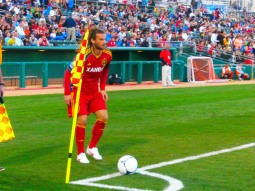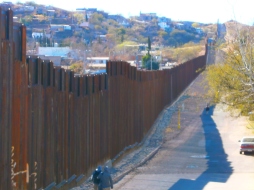 With all the negative media coverage that border areas get and all the attention to violence between drug cartels and law enforcement, on both sides of the border, I was eager to get down to Nogales and talk to citizens of this city. I sought to give them a forum in which they could express their views and concerns of and for their city. I also wanted to find out what the citizens of the city think about their safety and quality of life. Talking to many different people I got some answers I was not expecting.
With all the negative media coverage that border areas get and all the attention to violence between drug cartels and law enforcement, on both sides of the border, I was eager to get down to Nogales and talk to citizens of this city. I sought to give them a forum in which they could express their views and concerns of and for their city. I also wanted to find out what the citizens of the city think about their safety and quality of life. Talking to many different people I got some answers I was not expecting.
Many different people were telling me the same things. The general consensus I got from people was that the violence and danger being portrayed in the media about the border is not exactly accurate.
People like 51-year-old Mary Darling told me she feels completely safe in her city. She said she never hesitates to go out  in her yard or take her dogs for a walk in the early evening. She explained that there are no bullets flying over her head, that she does not wear Kevlar, and that taking a day to go into Mexico for shopping and dining is no “death-defying act”. This is something Darling feels more people need to know. However, Darling feels that security at random checkpoints and legal border crossings are not very efficient and can, at times, over step privacy boundaries by asking people, “Where are you going and what are you doing?”. She also feels that passport policies can make traveling through these checkpoints and border crossings a “drama” for some. People coming down from Canada for a golf tournament in Southern Arizona may be caught by surprise when they learn they need a passport to be able to pass through checkpoints on Interstate 19. After all, they already have shown their passport to get into America, so why would they need to show it again just to get from one city in Arizona to another? Upon passing through these checkpoints, a Canadian will be asked if they are a U.S citizen. When they say, “no”, they will face secondary questioning and possible detention, especially if they have left their passport in their hotel room, thinking they wont possibly need it traveling within the state of Arizona. If a debacle like this occurs, it will most likely discourage Canadians from making the trip down to Arizona if they have to worry about this kind of questioning and detention when all they are trying to do is participate in a golf tournament. These types of policies are a deterrent from travel, tourism and consumerism in Nogales and places like Tubac.
in her yard or take her dogs for a walk in the early evening. She explained that there are no bullets flying over her head, that she does not wear Kevlar, and that taking a day to go into Mexico for shopping and dining is no “death-defying act”. This is something Darling feels more people need to know. However, Darling feels that security at random checkpoints and legal border crossings are not very efficient and can, at times, over step privacy boundaries by asking people, “Where are you going and what are you doing?”. She also feels that passport policies can make traveling through these checkpoints and border crossings a “drama” for some. People coming down from Canada for a golf tournament in Southern Arizona may be caught by surprise when they learn they need a passport to be able to pass through checkpoints on Interstate 19. After all, they already have shown their passport to get into America, so why would they need to show it again just to get from one city in Arizona to another? Upon passing through these checkpoints, a Canadian will be asked if they are a U.S citizen. When they say, “no”, they will face secondary questioning and possible detention, especially if they have left their passport in their hotel room, thinking they wont possibly need it traveling within the state of Arizona. If a debacle like this occurs, it will most likely discourage Canadians from making the trip down to Arizona if they have to worry about this kind of questioning and detention when all they are trying to do is participate in a golf tournament. These types of policies are a deterrent from travel, tourism and consumerism in Nogales and places like Tubac.
 Another citizen I spoke to was Jesuit Priest, Father Peter Neeley. Neeley works for the Kino Border Initiative. the Kino Border Initiative (KBI), provides education, humanitarian aide and assistance along with other services for displaced or deported immigrants, migrants and refugees on the Mexican side of the border. They provide hot meals and room and board for women and children traveling alone. Many of these people have been deported from the U.S and have nowhere to go, nothing to eat and no money. Father Neeley runs a cafeteria on the Mexican side of the border that feeds 3 square meals to over 200 people on a daily basis. Neeley feels that the border has been militarized in the name of safety against terrorism. He explained outside a city hall meeting, that members of congress are not willing to vote against money for border security. However, Neeley feels that the resources are not appropriated where they need to be. He feels that more of the security should be used at the legal border crossings and checkpoints instead of trying to capture people crossing the border out in the middle of the desert. Granted, it is important to make sure people are not crossing the border out in the middle of the desert, but, according to Neeley, crossing the border legally is now taking 5 times as long. He explained that a trip across the border that used to take 5 minutes is now taking near 25 minutes. This can be credited to more scrutiny at the legal border crossings with an understaffed amount of patrol at these crossings, according to Neeley. He feels if the resources were used at the actual legal crossings, more people could flow in and out of the country and that this would, in turn, boost tourism, travel, trade and other types of consumerism between the borders.
Another citizen I spoke to was Jesuit Priest, Father Peter Neeley. Neeley works for the Kino Border Initiative. the Kino Border Initiative (KBI), provides education, humanitarian aide and assistance along with other services for displaced or deported immigrants, migrants and refugees on the Mexican side of the border. They provide hot meals and room and board for women and children traveling alone. Many of these people have been deported from the U.S and have nowhere to go, nothing to eat and no money. Father Neeley runs a cafeteria on the Mexican side of the border that feeds 3 square meals to over 200 people on a daily basis. Neeley feels that the border has been militarized in the name of safety against terrorism. He explained outside a city hall meeting, that members of congress are not willing to vote against money for border security. However, Neeley feels that the resources are not appropriated where they need to be. He feels that more of the security should be used at the legal border crossings and checkpoints instead of trying to capture people crossing the border out in the middle of the desert. Granted, it is important to make sure people are not crossing the border out in the middle of the desert, but, according to Neeley, crossing the border legally is now taking 5 times as long. He explained that a trip across the border that used to take 5 minutes is now taking near 25 minutes. This can be credited to more scrutiny at the legal border crossings with an understaffed amount of patrol at these crossings, according to Neeley. He feels if the resources were used at the actual legal crossings, more people could flow in and out of the country and that this would, in turn, boost tourism, travel, trade and other types of consumerism between the borders.
Lastly, I spoke with Connie Son, a 26-year-old owner of a clothing store called “Casa Sonia Fashion”. She explained to me that business has slowed considerably in the past three years. She told me how three years ago around Valentine’s Day, there was a line out the door. But this year, there are barely any customers shopping. Not only that, but Son explained that she has lost about 50 percent of her wholesale customers. Obviously terrible news for a small business owner. She and her family are hoping the economy will turn around soon because they do not want to lose their business.
One thing I kept hearing, that I was certainly not expecting to hear, was the fact that all these people feel incredibly safe within their city. Especially Mary Darling. Darling feels safe in her city and is extremely pleased with security at both the county and city level. Father Neeley explained that with all the law enforcement in Nogales; The U.S Marshals, homeland security, local law enforcement, border patrol and local sheriffs, there is a law enforcement officer for every three Nogales citizens. Connie Son explained that Nogales is an incredibly peaceful place. A place where people can leave their doors and windows unlocked, unlike her other home in California, which she describes as being a very dangerous area.
 Saturday night I covered the second evening of Desert Diamond Soccer Tournament play. At 6 p.m. the L.A Galaxy and Real Salt Lake played an intense game which the Galaxy won 2-0. Real Salt Lake came out strong initially taking shots and making Galaxy goal keeper Josh Saunders work hard early and often. However, red cards given to Salt Lake players Ned Grabavoy and Yordany Alvarez tipped the scale sin favor of the Galaxy. Soon after the ejection of those players the Galaxy were able to exploit their two man advantage and forward Paulo Cardozo scored from 20 yards out in the 81st minute of play. Just two minutes later a beautiful pass from midfielder David Beckham to forward Mike Magee doubled the Galaxy’s lead. Saturday night the tournament brought in a crowd of roughly 8500. Fans came from all over Arizona; places like Tucson, Benson and Saffrod. Others came from Los Angelos,California, and Albuquerque, New Mexico.
Saturday night I covered the second evening of Desert Diamond Soccer Tournament play. At 6 p.m. the L.A Galaxy and Real Salt Lake played an intense game which the Galaxy won 2-0. Real Salt Lake came out strong initially taking shots and making Galaxy goal keeper Josh Saunders work hard early and often. However, red cards given to Salt Lake players Ned Grabavoy and Yordany Alvarez tipped the scale sin favor of the Galaxy. Soon after the ejection of those players the Galaxy were able to exploit their two man advantage and forward Paulo Cardozo scored from 20 yards out in the 81st minute of play. Just two minutes later a beautiful pass from midfielder David Beckham to forward Mike Magee doubled the Galaxy’s lead. Saturday night the tournament brought in a crowd of roughly 8500. Fans came from all over Arizona; places like Tucson, Benson and Saffrod. Others came from Los Angelos,California, and Albuquerque, New Mexico.







